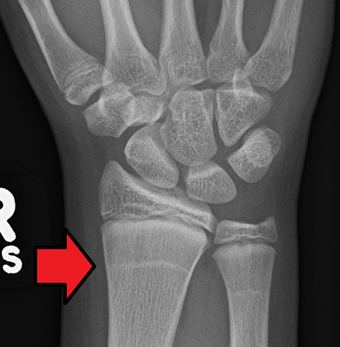Medicine:Growth arrest lines
From HandWiki
| Growth arrest lines | |
|---|---|
| Other names | Harris lines |
 | |
| Growth arrest lines in a child with an underlying bone disease | |
| Specialty | Orthopedics, radiology |
Growth arrest lines, also known as Harris lines, are lines of increased bone density that represent the position of the growth plate at the time of insult to the organism and formed on long bones due to growth arrest. They are only visible by radiograph or in cross-section. The age at which the lines were formed can be estimated from a radiograph. Harris lines are often discussed as a result of juvenile malnutrition, disease or trauma. Other studies suggest a reconsideration of Harris lines as more of a result of normal growth and growth spurts, rather than a pure outcome of nutritional or pathologic stress.[1] The lines are named after Henry Albert Harris (1886–1968), professor of anatomy at the University of Cambridge.[2]
References
- ↑ "Harris lines revisited: prevalence, comorbidities, and possible etiologies.". Am J Hum Biol 23 (3): 381–91. 2011. doi:10.1002/ajhb.21155. PMID 21387459. https://pubmed.ncbi.nlm.nih.gov/21387459.
- ↑ "Bone Growth in Health and Disease: The Biological Principles Underlying the Clinical, Radiological, and Histological Diagnosis of Perversions of Growth and Disease in the Skeleton.". JAMA 101 (27): 2143. 1933. doi:10.1001/jama.1933.02740520053040. https://jamanetwork.com/journals/jama/article-abstract/247040.
Further reading
- White, Tim D. (2001). Human Osteology (2nd ed.). San Diego: Academic Press.
- "Harris lines revisited: prevalence, comorbidities, and possible etiologies". American Journal of Human Biology 23 (3): 381–91. 2011. doi:10.1002/ajhb.21155. PMID 21387459.
- "Technical note: standardized and semiautomated Harris lines detection". American Journal of Physical Anthropology 137 (3): 362–6. November 2008. doi:10.1002/ajpa.20901. PMID 18711729.
- "Experimental assessment of nutrition and bone growth's velocity effects on Harris lines formation". American Journal of Physical Anthropology 145 (2): 169–80. June 2011. doi:10.1002/ajpa.21480. PMID 21469071.
 |

